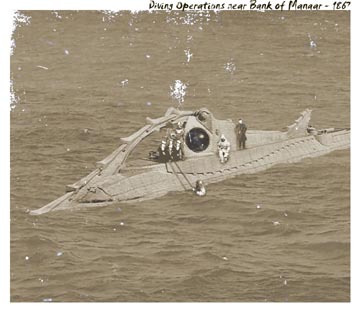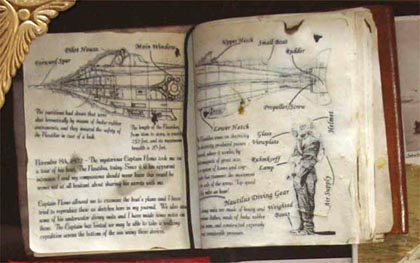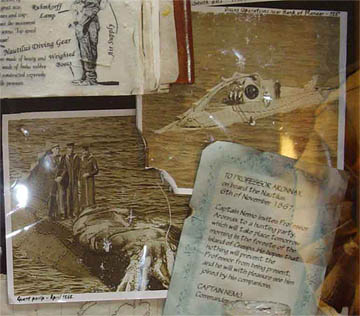Notes From the Curator's Office:
An
Art Project for a Favorite Novel
|

The
Last Possessions of Professor Aronnax hangs by my
desk.
|
A do-it-yourself way to commemorate your favorite book
or movie and add a conversation piece to your home.
(09/09) One of my favorite books as a boy was an abridged
version of Jules Verne's 20,000 Leagues Under the Sea.
Later on I would go on to read the full unabridged version
multiple times, but that first book, with its beautiful color
illustrations, remains one of my best childhood memories.
Though I never saw the motion picture until I was an adult,
I'm also a fan of Disney's 1954 movie version of the book.
The film, starring James Mason and Kirk Douglas, which actually
includes elements from both the 20,000 Leagues Under the
Sea and Verne's Mysterious Island, is a classic
retelling of the tale. In particular Captain Nemo's submarine,
the Nautilus, designed for the film by Harper Goff,
is a true work of art. A Victorian-designed machine in the
shape of a sea monster, it was steampunk decades before the
term was invented.
Because of this, when I decided to do a series of graphic
novels based on classic books, 20,000 Leagues was my
first choice. This gave me an opportunity to design my own
Nautilus and try and capture Verne's story in pictures.
(For those unfamiliar with the story you may want to look
at my graphic novel.)
Art Project
About a year ago I came up with the idea for an art project
based on classic literature. The idea would be to build a
series of objects that appear in the book and arrange them
as a display. For example, if you were doing a version based
on Mary Shelly's book Frankenstein, you might want
to include aged pages that recreat some of the doctor's laboratory
notes.
My obvious choice for this project was, of course, 20,000
Leagues Under the Sea. For those of you unfamiliar with
the story line, it starts in 1867 when Professor Aronnax and
his two companions find themselves forced to join Captain
Nemo and his crew on an undersea voyage in the mysterious
submarine, Nautilus. The voyage lasts for a distance
of 20,000 leagues (a league is an obsolete measure of distance
equal to about three miles or five and half kilometers) and
this, of course, is what gives the book its name.
|

A
composite photo from different images created with Photoshop,
then "aged."
|
Eventually Aronnax and friends escape, but the fate of the
Nautilus, and its captain, are unknown, at least until
Verne wrote the sequel Mysterious Island.
During the voyage Professor Aronnax records his observations
in his diary and collects items of scientific interest. It
occurred to me that this was the perfect launching point for
my project: Aronnax could only have taken a few things with
him when he fled the Nautilus. What would they be?
Whatever these objects were they would make the perfect collection
for my project. Now one restriction with this was that I wanted
to present my work in a shadow box that could hang on the
wall. Whatever the good Professor brought back with him would
have to fit into a space no wider than 1 and ¾ inches, the
width of my chosen box.
So what would Aronnax bring back with him? One obvious item
would be his journal. He constantly references it and the
book is supposedly based on notes from it.
Journal
My first job was to get or make a journal that could pass
for one owned by a French academic in 1866. One of the prerequisites
for the journal was that it should have removable pages to
make it easy for me to create the contents. I found someone
on Ebay who makes journals that fit the bill. The one I selected
has a leather cover with rough-looking paper. The pages are
held in with a string that double as a means to tie up the
journal when not in use. It looks precisely like what I might
expect somebody to be carrying as a diary in the mid-19th
century.
|

The
reproduction of Aronnax's journal showing the Nautilus.
|
I untied the string to remove the pages. Because I don't
have the ability to write as neatly or precisely with a fountain
pen as an 19th century professor would, I decided to compose
the interior pages on my computer using a font that looks
like neat handwriting. In addition to the notes, the page
contains a drawing of the Nautilus and a diagram of
a diving suit.
Here I had to make a few decisions. Aronnax was French and
undoubtedly his diary would be written in this language. Since
I don't read or write French this was a problem. Also, most
of the people viewing the work probably wouldn't speak French
either, so the meaning of the notes would be lost to them.
I decided to cheat and have the Professor write his journal
in English. A second consideration was what the drawing of
the Nautilus should look like. There have been many
interpretations of this famous submarine in different books
and movies. I even did my own for my graphic novel. In fact,
Verne enthusiasts Michael & Karen Crisafulli keep a wonderful
website dedicated to different designs of the Nautilus
(The
Catalog of Nautilus Designs).
I decided to do my drawing in the style of design that Goff
did for Disney. One of my ideas for the piece was to make
it a bit of a riddle and not explicitly tell the viewer what
he was seeing, but let him puzzle it out for himself. The
Goff design, in addition to being striking, is well known
enough by anybody who has seen the film to be a major clue
to understanding the piece.
Since the journal was to be displayed with pages open inside
a glass case, there was no need to create contents for the
entire book, just the open pages. This was done with Photoshop.
To make the page look more like it was done by hand instead
of machine, I put some of the text at an angle and included
little mistakes like ink blots.
With some trial and error I was able to get the content printed
on the rough paper of the diary. After aging the paper and
tying my pages back into the cover, my first item was complete.
Map
The second item that occurred to me was a map. The Professor
undoubtedly would have kept track of the Nautilus'
location during the voyage. I tackled this item by first going
to the internet and finding a large scale photo of a map from
the mid-19th century. Pulling this into Photoshop, I created
a line following the Nautilus' course as described
by the book and putting in little notes for significant events
in the voyage. For example, a note like "Battle with the Poulps"
signifies the conflict with the giant squid.
Just as an aside, though everyone thinks of the Nautilus
as being set upon by a single giant squid, as in the Disney
movie the, Verne book actually had the submarines crew battling
a whole troop of these monsters.
|

Old
photographic prints and a note from Captain Nemo.
|
The map was printed out, and the paper aged. My method for
this was to brew a cup of strong tea, then carefully wipe
it on the paper to give the material a stained effect. While
the paper was still wet I burned the edges to give a torn,
uneven look. A bit of folding and crumpling was also helpful.
Fake Photos
Though photography was really primitive during the era when
the book takes place, I decided that Aronnax must have used
some of Nemo's advanced technology to take some pictures while
aboard the submarine.
I used images found on the internet to create my photos.
When Disney World first opened the Magic Kingdom back in 1971
it included a submarine ride with versions of Goff's Nautilus
big enough for guests to enjoy. Some pictures of these, combined
with ocean pictures, old photos of sailors and hardhat divers
and a dead squid gave me three pictures for my project. The
images were then aged through Photoshop (There are several
tutorials on the web about how to do this so I won't go into
the method here.) and printed at my local drugstore. To make
the aging even more convincing, I roughened the edges of the
prints and added a few fold lines.
Perhaps the biggest challenge was to create a sample of giant
squid arm in a specimen jar. With a width of only 1 and ¾
inches to work with in the box, this eliminated most real
specimen jars. I finally found a vase at the local arts and
crafts store that was essentially just a cylinder just small
enough to make it in the box. I fabricated a tip of the squid
arm out of Crayola Model Magic and painted and sealed
it. I submerged it not in alcohol (as you might a real specimen)
but clear Elmers glue (this way after the glue dries there
is no problem with the jar tipping over inside the box and
liquid getting all over the place).
I added several other papers and a label with the title "The
Last Possessions of Professor Aronnax." Included on the label
was a picture of the Professor (really a shot of Jules Verne)
and the words:

A tentacle
from "poulp of unknown type" floats in its
specimen jar.
|
The objects in this case are the only known possessions
that Prof. Aronnax brought back with him from his extraordinary
sea journey of November 1867 through June of 1868.
The completed exhibit hangs by my desk where the squid tentacle
often catches people's attention.
Some people try to ignore it. Others stare at it. Some understand
it almost immediately. Others are bewildered and have to have
the whole thing explained to them. In any case it makes for
a good conversation piece.
There are probably a lot of books that would lend themselves
to this kind of project, so if you have an interest in arts
and crafts and literature you might want to try doing something
like this yourself. You might include the flask that Dr. Jeykll
used to drink his insidious potion. Or perhaps part of an
arm severed from an invading Martian tripod. The possibilities
seem endless. If you do create something, drop us a line here
at the museum and tell us about your project we will try and
feature it here on the site.

Copyright
Lee Krystek 2009. All Rights Reserved